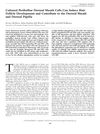TLDR DS cells in hair follicles can help form and restore hair, especially in hair loss conditions.
The study explored the relationship between dermal papilla (DP) and dermal sheath (DS) cells in hair follicles, revealing that DS cells, especially those in the dermal sheath cup (DSC), could induce hair follicle formation and integrate into existing follicles, challenging the view of DS cells as merely a reserve population. This suggested a potential role for DS cells in hair restoration, particularly in androgenetic alopecia, by converting small vellus follicles into larger terminal structures. The study also noted the dynamic interconversion between DS and DP cells during the hair cycle and proposed that DS cells might aid in dermal wound repair. However, it was suggested that while cell movement from the follicle to the dermis was possible, reverse movement was unlikely, and altered migration in androgenetic alopecia could lead to follicle miniaturization.
 208 citations
,
December 2003 in “Journal of Investigative Dermatology”
208 citations
,
December 2003 in “Journal of Investigative Dermatology” Certain cells from hair follicles can create new hair and contribute to hair growth when implanted in mice.
 54 citations
,
June 2003 in “The journal of investigative dermatology. Symposium proceedings/The Journal of investigative dermatology symposium proceedings”
54 citations
,
June 2003 in “The journal of investigative dermatology. Symposium proceedings/The Journal of investigative dermatology symposium proceedings” Disruptions in hair follicle fibroblast dynamics can cause hair growth problems.
158 citations
,
May 2003 in “Journal of Investigative Dermatology” Hair growth is influenced by dynamic changes in hair follicle cells, which could help treat hair loss.
1010 citations
,
August 2000 in “Cell” Hair follicle stem cells can form both hair follicles and skin.
192 citations
,
October 1998 in “Experimental Dermatology” Androgenetic alopecia involves complex hair follicle changes and knowledge gaps remain.
31 citations
,
September 1996 in “Differentiation” The upper dermal sheath can regenerate hair in rats.
125 citations
,
August 1992 in “Development” Implanted dermal papillae can induce hair growth in rat ear wounds.
 1 citations
,
January 2017 in “Elsevier eBooks”
1 citations
,
January 2017 in “Elsevier eBooks” The document concludes that new treatments for hair loss may involve a combination of cosmetics, clinical methods, and genetic approaches.
 November 2023 in “Materials Today Bio”
November 2023 in “Materials Today Bio” Light therapy might help treat hereditary hair loss by improving hair follicle growth in lab cultures.
 May 2023 in “Journal of Clinical Medicine”
May 2023 in “Journal of Clinical Medicine” New understanding and treatments for hair loss are improving, but more research is needed.
 August 2024 in “Stem Cell Research & Therapy”
August 2024 in “Stem Cell Research & Therapy” New regenerative therapies show promise for treating hair loss.
 July 2025 in “World Journal of Stem Cells”
July 2025 in “World Journal of Stem Cells” Stem cell-derived exosomes could be a promising new treatment for hair regrowth.
December 2025 in “Cosmetics” New treatments for alopecia show promise in restoring hair growth by targeting immune and hormonal factors.







